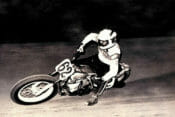May the roads be clear, the sun at your back, and a KTM 890 Duke R between your legs.
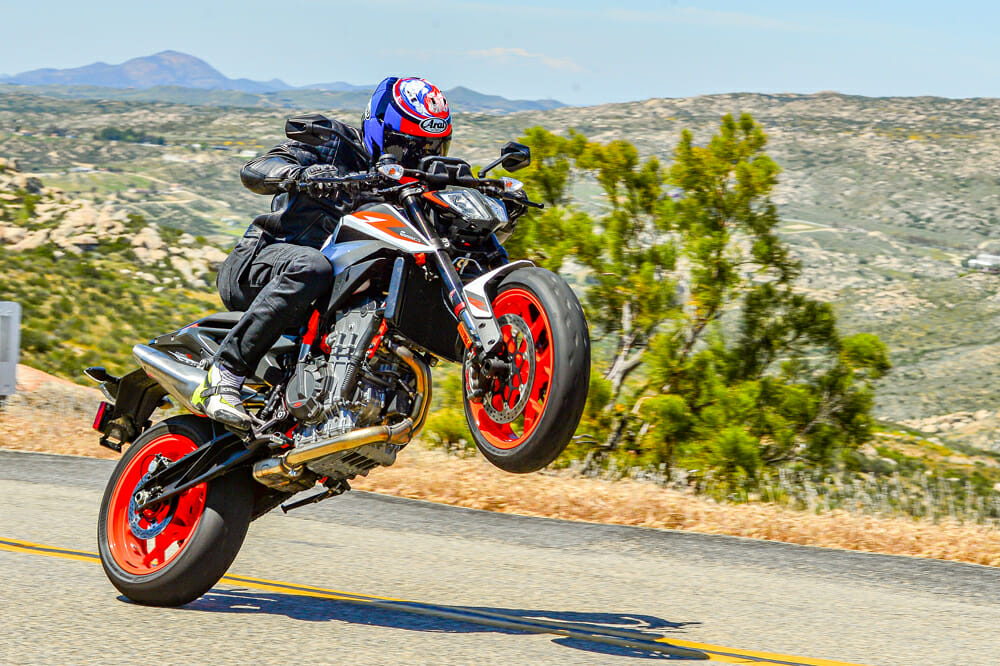
Photography by Kit Palmer
You’ve got to admire the board at KTM AG. Headed by CEO Stefan Pierer, the Austrian company is firing on all cylinders these days, each year releasing a string of new bikes that get the juices flowing fast and furious, on either road or dirt.
Being a street bike guy, I’m more in tune with the latter, as my dirt skills amount to play riding at best. And having spent more than my fair share of time on every version of the 1290 Super Duke R since it came out in 2014, I have first-hand experience of seeing KTM’s street bikes get better every year—or every other year.
That brings me to today’s main course, the 2020 KTM 890 Duke R. Born from the loins of the 790 Duke that came out in 2018 here in the U.S. (2017 for the rest of the world), the 890 Duke R is every bit the 1290 Super Duke R’s little brother, far more so than the 790 ever was.
That 790 is an excellent little bike, but the 890 takes everything up several notches. It’s a more versatile motorcycle, and its target audience is, well, everyone from pro riders to beginners looking to get into the KTM fold.
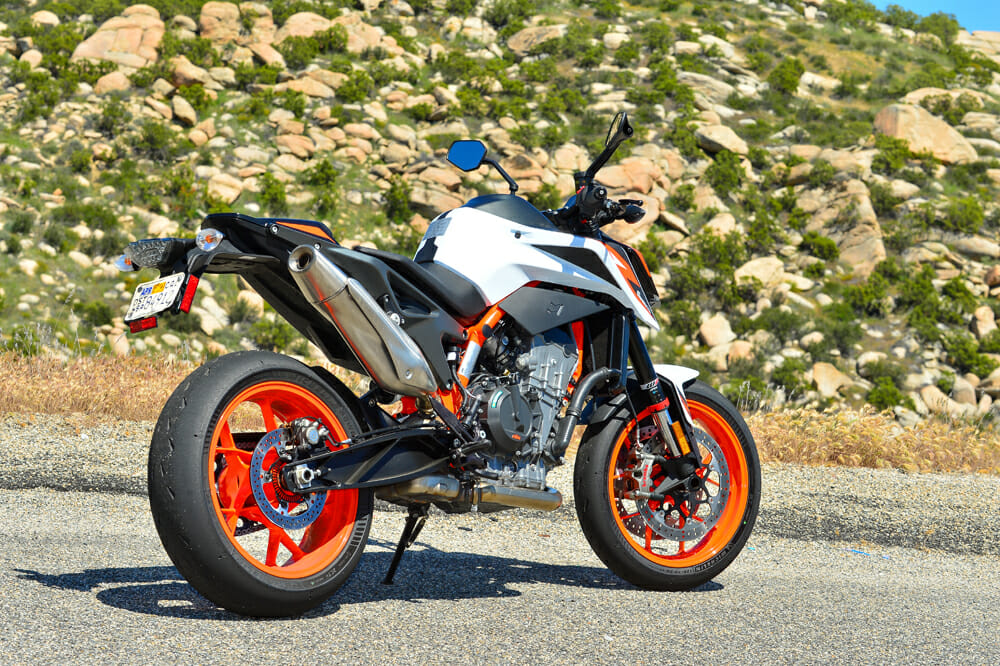
2020 KTM 890 Duke R Review | The New Motor
Let’s have a little look at what makes an 890 Duke R, shall we? This is not simply a case of a few more cubes and some new graphics. Bored and stroked over the 790 (88 x 65.7mm for the 790 vs 90.7 x 68.8mm for the 890) and with compression bumped up from 12.7:1 to 13.5:1, the parallel twin is essentially all new.
From the top down, there’s shorter intake funnels, with KTM removing the connection between the throttle bodies so you can now tune each cylinder individually; a new manifold pressure (MAP) sensor has been developed by the Italians at Dell’Orto; a redesigned cylinder head houses longer lift cams and 1mm bigger intake (37mm) and exhaust (30mm) valves and the redesigned conrods push and pull two new, lighter forged box pistons.
Perhaps the most significant improvement of the 890 over the 790 has been the heavier crank. KTM claims the crankshaft now has 20 percent more rotational mass than before, helping several areas including better low-rpm throttle response and chassis balance when cornering.
The motor also has a new balancer shaft fitted to help cancel many of the vibrations of the parallel-twin layout.
As for the transmission, this is another area KTM has paid close attention to. The throw (how high the lever moves when you shift gears) has been shortened dramatically, which, when combined with the optional Quickshifter+ system from the KTM PowerParts catalog makes for an incredibly short, light shift action. We didn’t ride the 890 without the Quickshifter+ system, but the gearshift was so good we’d insist if you were in the market for an 890 Duke R, shell out the extra $ and have KTM turn the system on.
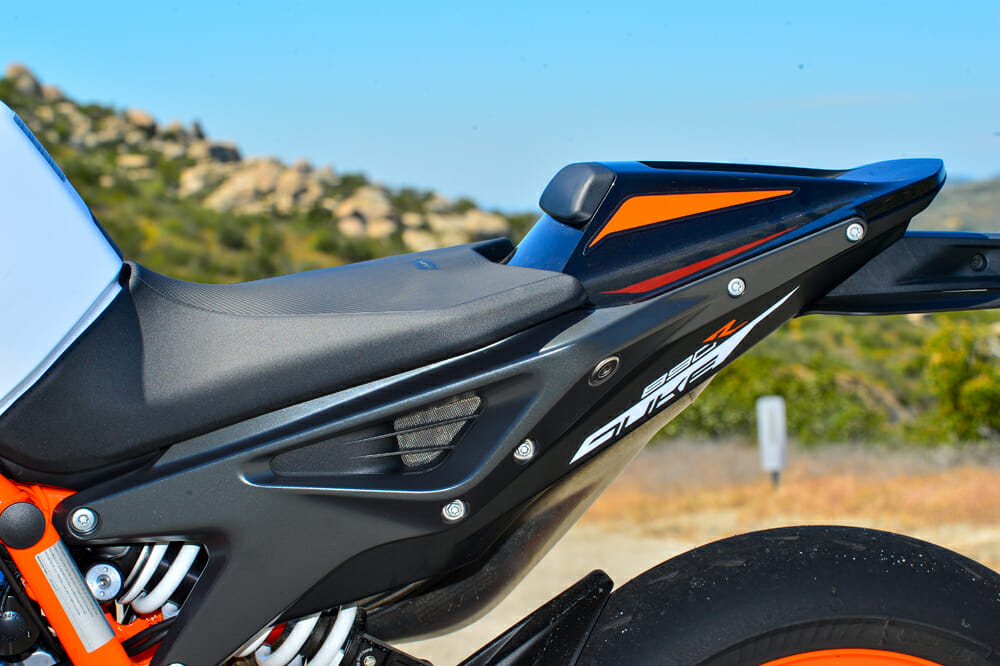
2020 KTM 890 Duke R Review | Chassis and Running Gear
The 790 Duke forms the basis for the 890’s chassis in the tubular steel construction (a trademark for all KTM street bikes). Painted orange for the 890 R model over the 790’s black, the chassis itself is essentially as it was, but it’s the suspension and what’s not on the 890 that makes it interesting.
KTM’s in house suspension partner, WP, takes care of the springers, with the fork upgraded from an unadjustable 43 mm Arex fork to one that now has adjustable compression and rebound damping, but strangely not preload adjustment.
At the rear, WP has fitted their fully adjustable (including high- and low-speed compression damping) shock that’s gained 10mm of wheel travel for 5.9 inches. Much like the 2020 1290 Super Duke R, the 890’s swingarm has been placed higher in the chassis (ride height has been increased by 15mm) to give better anti-squat properties to help keep a tighter line when hard on the gas and improving ground clearance.
The rider utilizes beefier footpegs and sits higher up and closer to the bar than on the 790—which itself has been placed a little lower on the top triple clamp—putting more weight on the front helping to increase turn speed and feel for the front tire. The pegs themselves sit higher up and further back on the chassis, again, to place more weight toward the front, while the seat height has also grown from 32.5 to 32.8 inches.
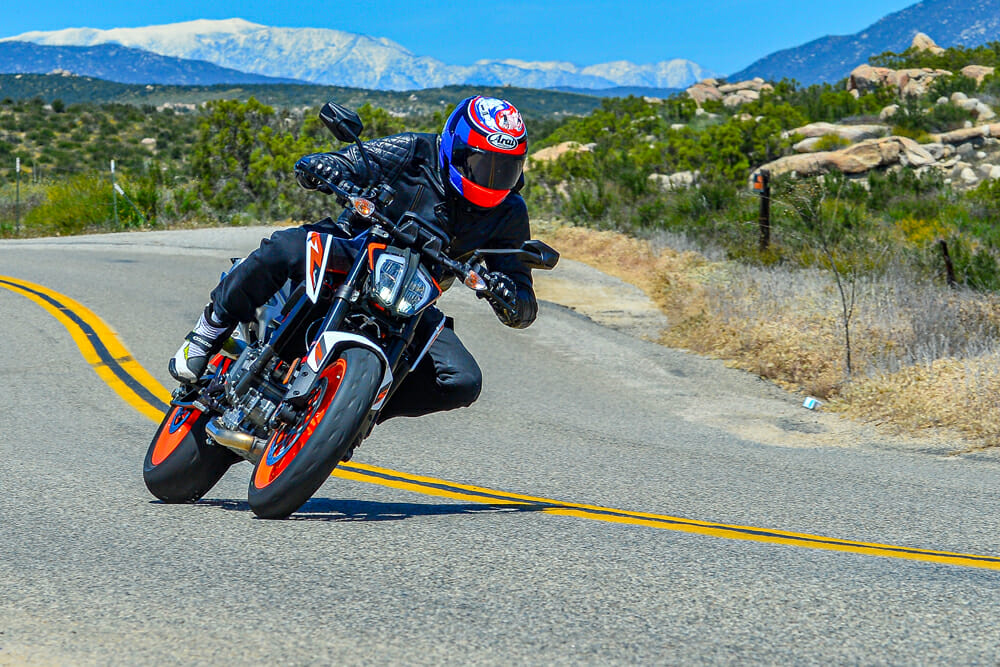
For the first time on any Duke model sold in the U.S., this 890 will not come with passenger pegs as standard fitment. KTM claims their absence, along with the fitment of the single seat cowl, takes a hefty 7.2 pounds off the sprung mass, helping the engineers get weight down to a claimed 365 pounds dry.
Another first for the Duke range is the fitment of Michelin tires as standard in the Power Cup 2 units. The previous 790 came out with Maxxis rubber, while the new 1290 came out with Bridgestone S22 tires. When we spoke to Jeremy McWilliams at the 1290 launch in Portimao, he mentioned the Michelins proved to be the best compromise between road holding, corner tip-in feel, weight, stability and overall grip for the 890 platform, beating out Bridgestone, Pirelli and Continental for the 890 gig.
As for the brakes, these are the same you’ll find on the 1290 Super Duke R. Brembo Stylema four-piston calipers up front, gripping 320 mm discs (up from 300 mm) all modulated via a Brembo MCS (Multi-Click System) master-cylinder, which allows for lever and span adjustment. Another 2.6 pounds has been saved on the braking system alone, all of which is unsprung weight.
At the rear, the same Brembo single piston caliper and 240mm disc setup is retained from the 790, with Bosch’s Cornering ABS system fitted as standard that cannot be switched off, as per new Euro 5 rules.
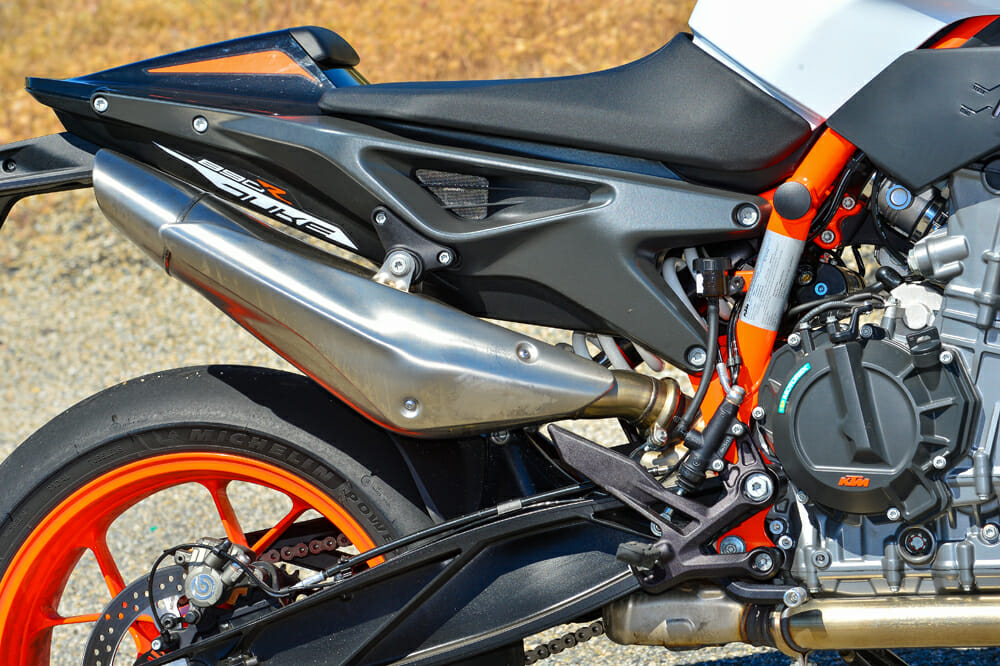
2020 KTM 890 Duke R Review | All in the Electronics
As you’d expect, pretty much everything you’ll find on the 1290 Super Duke R can be found on the 890 R—a six-axis IMU mitigates the Cornering ABS function, and there’s four different riding/throttle modes: Rain, Street, Sport and the optional Track setting (which KTM did not yet have a price for as Cycle News published this article) that unlocks the nine-stage traction control and anti-wheelie system.
In Road, Rain or Sport settings, the KTM’s revised traction control (Motorcycle Traction Control—MTC) system is either on or off, and included as standard is the KTM-specific Motor Slip Regulation (MSR) that acts as an electronic slipper clutch to stop the back-end from locking up under high-rpm downshifting.
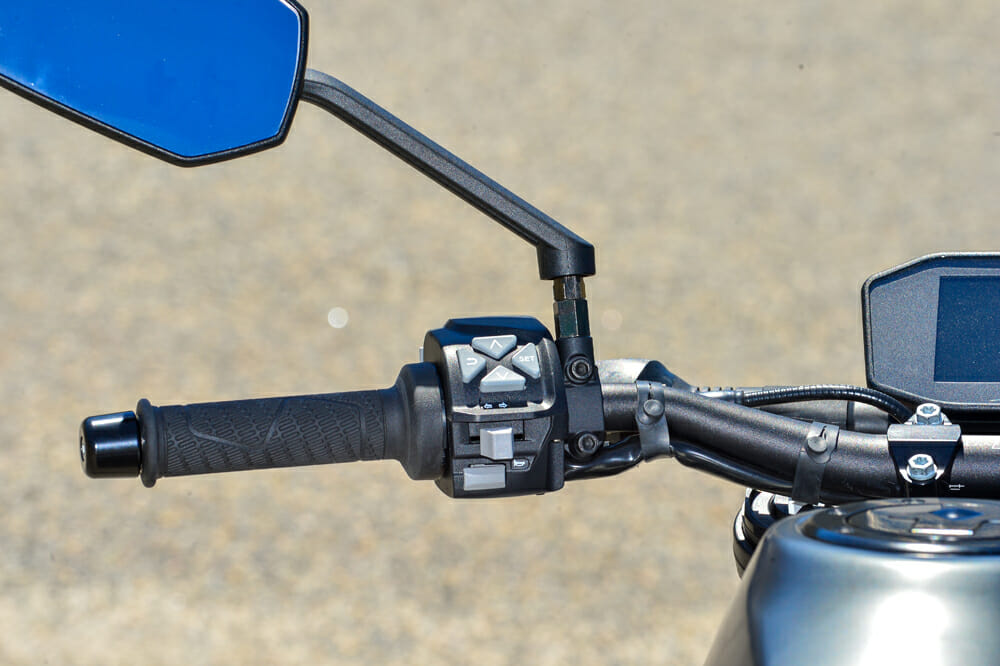
As for the optional extras, there’s plenty to choose from on the electronic front: heated grips, cruise control, alarm system, quickshifter and the KTM My Ride control unit, that allows you to pair your phone and run turn-by-turn navigation, take calls and texts, etc.
VIDEO | 2020 KTM 890 Duke R Review
2020 KTM 890 Duke R Review | From the Hot Seat
So what do all these goodies add up to? Well, I can give the short version and say the 890 is absolutely bitchin’, and if you’re into riding at all you’ll understand. But being so simple doesn’t tell the whole story.
Yes, the ride is awesome, but there’s plenty of impressive sideshows at play here. There are three standout players here—the motor, gearshift and how snappy and agile the chassis is. With a claimed 120 horsepower from the parallel-twin, the Duke R delivers as mellow or mental experience as you like. There are four specific personalities lurking in the ride modes, with the ride becoming progressively angrier until you hit go on the optional Track mode. At this point, the throttle response is almost 1-1, and the little 890 rips wheelies in the first three gears without hesitation, and fourth gear with a bit of persuasion.
The spread of power is so vast, you’ve always got some decent acceleration on hand when you need it. From 2000 rpm right through to the 10,500 rpm redline, the little 890 pulls far harder than it has any right to. The lighter engine internals prefaced earlier come to the fore here, helping the motor tear through the rev range, but they are offset by the stability offered by the heavier crankshaft. The initial throttle response is smoother and more controlled than on the 790, especially when cranked over and you start feeding in the gas. Dial the electronics back and you’ll eventually be met with an angry, bratty little bike, one that throws wheelies like middle fingers at a punk concert, and when you combine that characteristic with beautifully quick and smooth gearshift and the supremely agile chassis underneath you, it’s impossible not to have a good time.
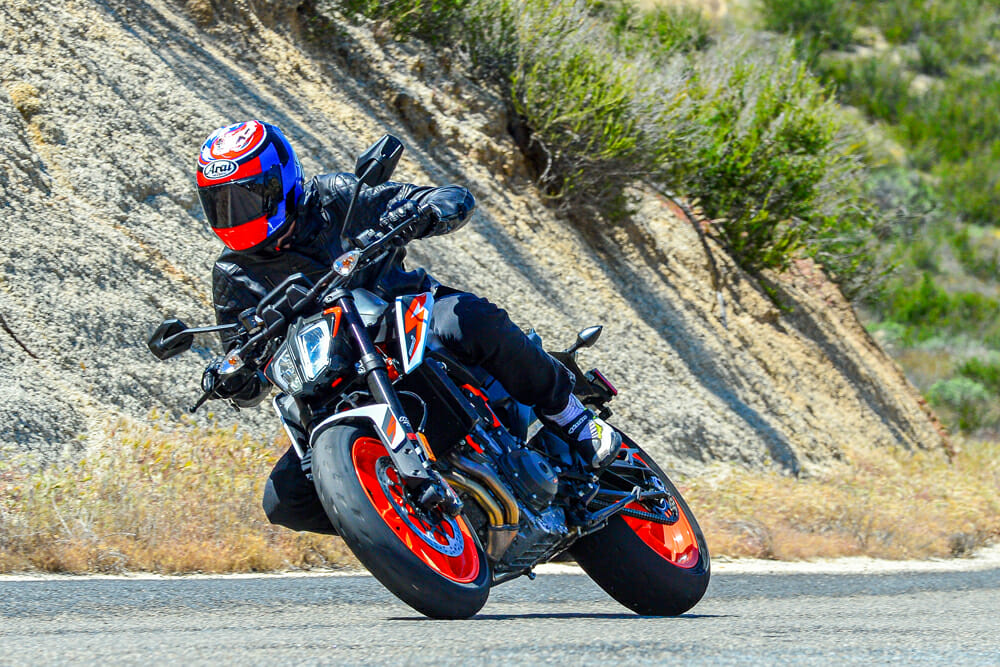
It’s economical, too. We got an impressive 50.3 mpg gas mileage on the 890, but the riding we did was pretty open and flowing, so if you’re riding in the city with lots of stop-and-go, you can expect that level to drop somewhat.
The suspension is vastly improved over the 790’s, as is the ride quality with the swingarm sitting taller in the frame. The 890 Duke R simply annihilates corners—look where you want to go and you’re there, with the best part being that the agility getting into the corner is matched by the stability once you’re in it. As the bike is so light you can easily correct your line mid-corner if you overcook your entry, and the chassis responds well to a little rear brake in the mid part of the turn.
The brakes are almost too powerful for the little 890. Almost. The Brembo MCS front master-cylinder coupled with the Stylema calipers off the 1290, has such exceptional feel at the lever. Trail braking is a joy with this setup, and the Bosch Cornering ABS system is so unobtrusive you don’t know it’s working in the background.
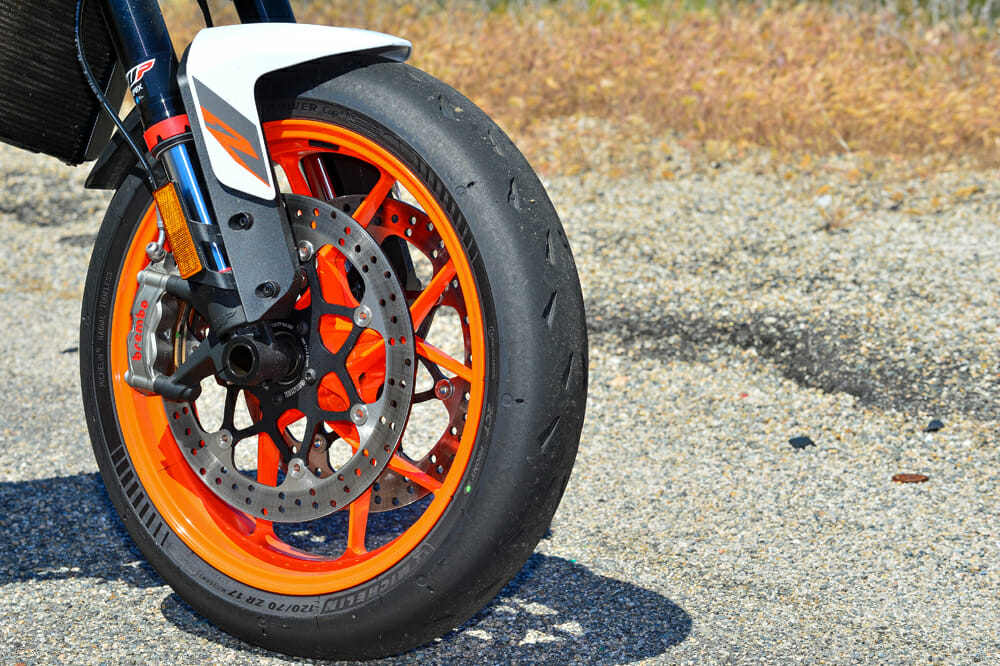
Overall ride comfort is good when you consider the engineers made the rider triangle racier with more weight directed towards the front end. You’re hunched forward more than the 790, helping you load that exceptional front Michelin up to utilize all that grip. We didn’t get the chance to ride the 890 in the rain, but we suspect those Michelins with their deep grooves—which are much deeper than what you’ll find on the equivalent Dunlop or Pirelli—will scoop the water out of the way brilliantly.
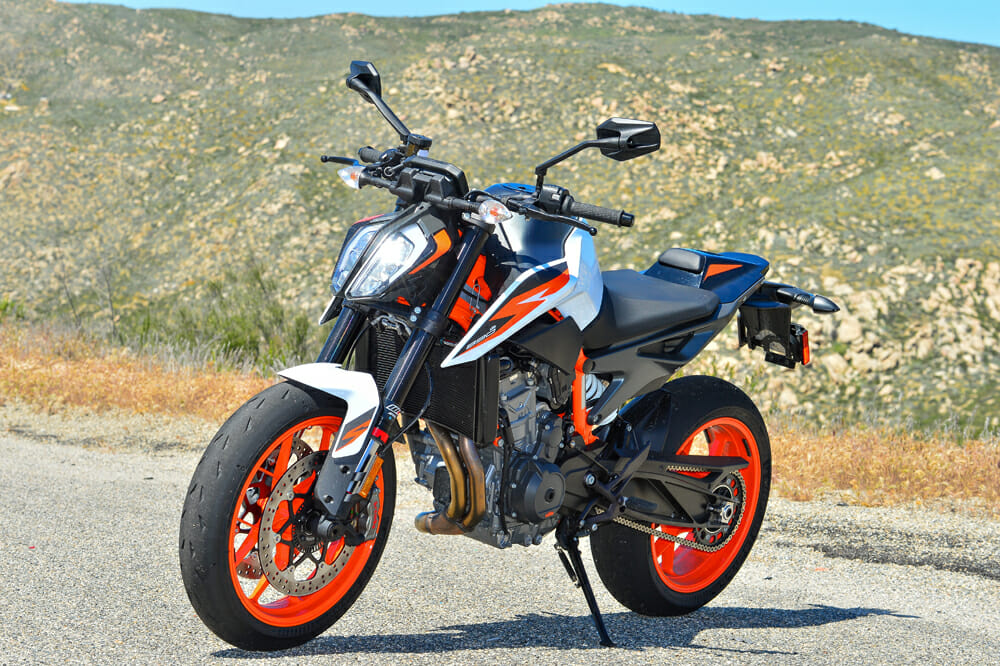
The electronics are intuitive and easy to use once you spend a bit of time getting used to them. The good news is if you’re coming from pretty much any KTM street bike from about 2017 or sooner, you’ll already be used to the layout and how everything works. As stock, the electronics are a little sparse, but the PowerParts catalog, as mentioned, will sort out right out (for a price, obviously).
I came off the 1290 at the world launch in the Portuguese sun pretty convinced I’d found the perfect naked bike. That 1301cc brute is a heavyweight boxer that’s light on his feet, but the middleweight version might just be a better street bike. The 890 Duke R is going to take a hell of a beating from the other manufacturers if they’re to top it—think Triumph Street Triple 765, the Kawasaki Z900 or the Yamaha MT-09. All are brilliant bikes, but could struggle to top the 890 in terms of sheer enjoyment.
KTM has created a motorcycle absolutely anyone of any level can enjoy. The 890 Duke is the perfect mix of bratty, snappy character, civil on-road manners, intuitive electronics and enough practicality (more if you chose to fit the option passenger pegs and seat) to be any bike you want it to be.
But being sensible isn’t really in the 890 Duke R’s nature, especially when you unleash the Track package. This bike is an absolute riot, and now a true worthy little brother to the 1290 Super Duke R. CN
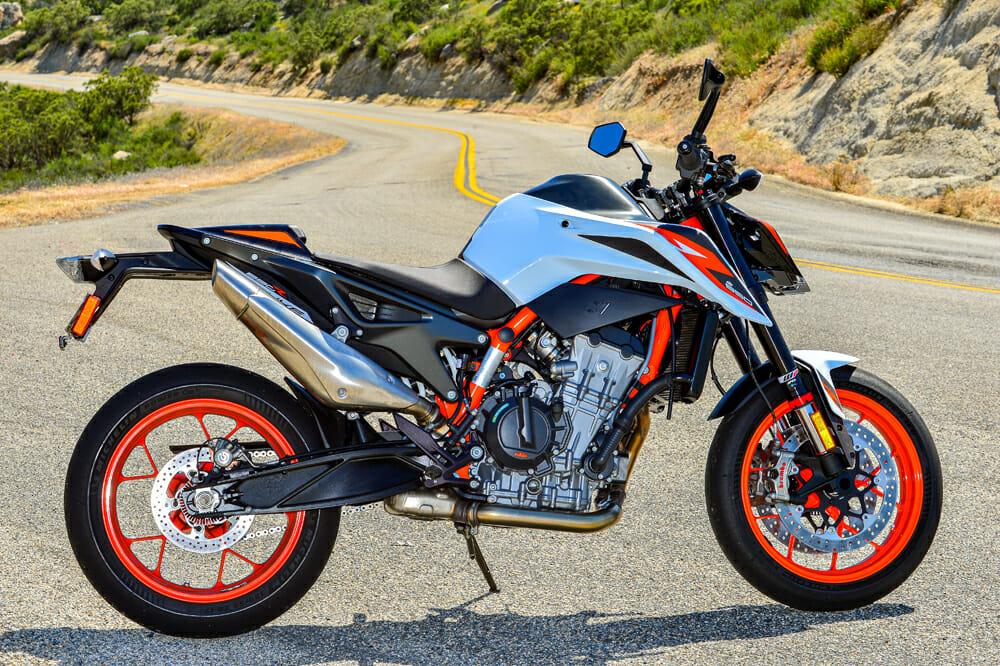
2020 KTM 890 Duke R Specifications
| MSRP: | $11,699 |
| Engine: | Liquid-cooled, DOHC, 8-valve, 4-stroke, parallel twin |
| Displacement: | 890cc |
| Bore x Stroke: | 90.7 x 68.8mm |
| Horsepower (claimed): | 89kW (121 PS) at 9250 rpm |
| Torque: | 99 Nm at 7750 rpm |
| Compression ratio: | 13.5:1 |
| Transmission: | 6-speed |
| Fuel system: | DKK Dellorto w/ 46mm throttle body |
| Lubrication system: | Pressure Lubrication w/ 2 oil pumps |
| Primary drive: | 39:75 |
| Final drive: | 16:41 |
| Clutch: | Cable operated, w/ PASC slipper |
| Engine Management: | Bosch EMS w/RBW |
| Traction control: | MTC (lean-angle sensitive, 3-Mode, Track optional |
| Frame: | Chromium-Molybdenum-steel |
| Subframe: | Aluminum |
| Front suspension: | WP Apex 43, fully adjustable |
| Rear suspension: | WP Apex Monoshock, fully adjustable |
| Front wheel travel: | 5.5 in. |
| Rear wheel travel: | 5.9 in. |
| Front brake: | 2x Brembo Stylema 4-piston, radially mounted caliper, 320mm discs, ABS |
| Rear brake: | Brembo single-piston floating caliper, 240mm disc, ABS |
| Front wheel: | Cast aluminum, 3.50 x 17-in. |
| Rear wheel: | Cast aluminum, 5.50 x 17-in. |
| Rake x trail: | 65.7° x 99.7mm |
| Wheelbase: | 58.3 in. |
| Ground clearance: | 8.1 in. |
| Seat height: | 32.8 in. |
| Fuel capacity: | 3.7 gal. |
| Weight (dry, claimed): | 366 lbs. |
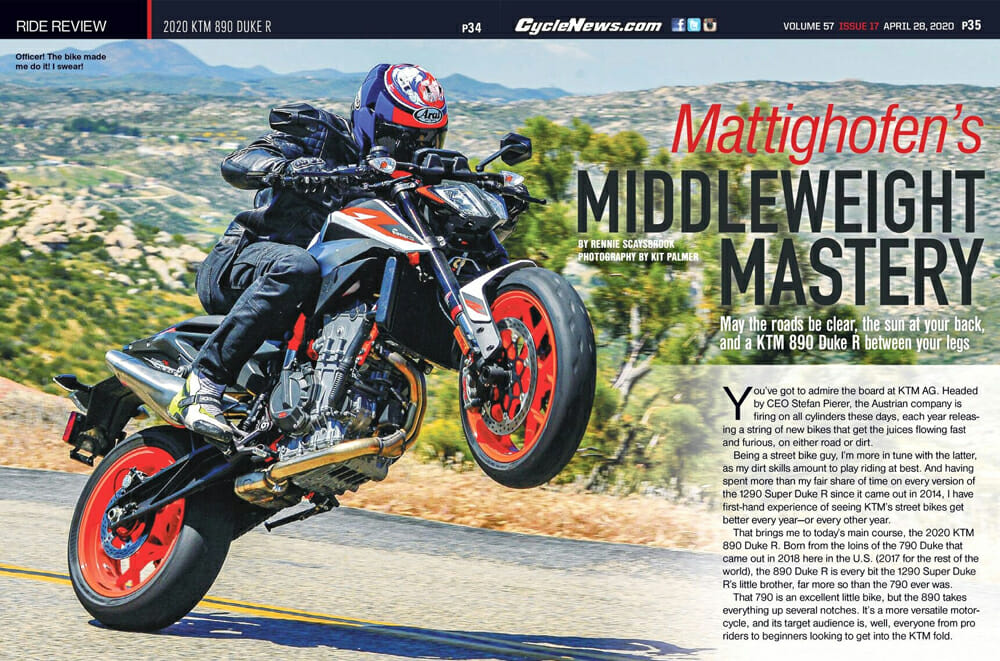
Click here to read 2020 KTM 890 Duke R Review in the Cycle News Digital Edition Magazine.
Click here for the latest Cycle News Standard motorcycle reviews and news.
Click here for more KTM motorcycle reviews and news.
